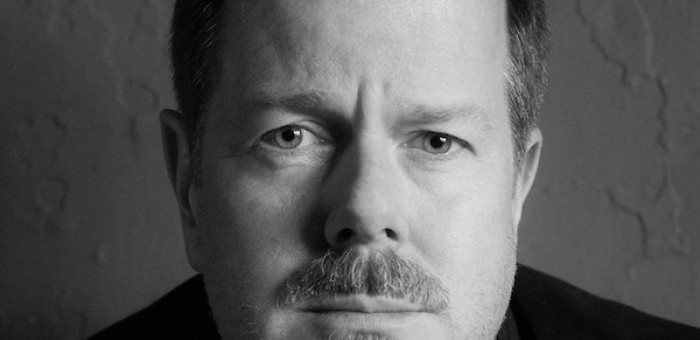Dec 9, 2025 12:28 PM
In Memoriam: Gordon Goodwin, 1954–2025
Gordon Goodwin, an award-winning saxophonist, pianist, bandleader, composer and arranger, died Dec. 8 in Los Angeles.…

Ken Vandermark is the leader of Marker, a new ensemble that fuses game pieces with sonic tableaus and melodic compositions.
(Photo: Jim Newberry)On Aug. 20, Ken Vandermark’s latest band, Marker, concluded a residency at Sugar Maple, a craft beer bar in Milwaukee. The performance was an experiment of sorts for a new project. The band had only performed once before, and that was on Jan. 21, as part of the Hit the Ground Running Fest, a Planned Parenthood fundraising event held at Chicago’s Elastic Arts venue.
It took almost two years for Vandermark to shape this project. He was looking for an instrumentation as well as musicians that would present new challenges. For instance, he made a conscious decision not to use a bass, settling instead on a lineup of young players featuring guitarists Andrew Clinkman and Steve Marquette, violinist/keyboardist Macie Stewart and drummer Phil Sudderberg.
“The age difference is noticeable,” said Vandermark. “It was weird at first because I was going to be ‘Mr. Vandermark,’ but I didn’t want to be their mentor. And it was really fascinating and rewarding to see how they think musically. Their curiosity felt like the cross-pollination that was happening in the mid-’90s in Chicago with musicians from various backgrounds.”
For their last show, Marker presented two suites built around nine of the 14 compositions that make up the band’s current repertoire. The compositions fall into three categories: game pieces with cues to indicate a choice between various actions; tableau pieces that can be superimposed on sonic backgrounds; and melodic pieces. Before each performance, Vandermark devises how each suite is going to be constructed and sequenced. “My goal is to see how we can manipulate, cut up and reorganize the pieces in real time to create new situations for the improvisers,” he said.
Given the nature of the process, the suites had a polymorphic quality. They merged or juxtaposed different genres such as funk, blues-rock, chamber music and free improvisation, among others. The compositions made extensive use of repetitive riffs and vamps before making room for solos. Stewart’s array of sounds on her electric keyboard gave each part a separate identity and character. The music was alternately loud and quiet, full and desolate, pointillist and expansive. Vandermark seemed most revelatory on tenor saxophone, but also relied on the clarinet, the bass clarinet and the baritone saxophone.
Adrienne Pierluissi, the owner of Sugar Maple, not only came forward with the residency proposal but also suggested to show a Chris Marker movie after each performance. The French director’s influence on Vandermark partially explains the band’s name (the other reason being the use of markers as points of reference or cues during the performance).
At the core of the project is the role of memory. The idea of memory in music had captured Vandermark’s attention well before he got acquainted with the director’s work, but his interest was renewed after viewing movies such as Sans Soleil or La Jetée. “I wanted to explore the idea of memory when you’re listening—from the audience perspective—and how it does or doesn’t affect the perception or understanding of the music,” he said. “My goal is to superimpose pieces in a fluid way to bring elements back like an echo or anticipate what will happen later in the set. The challenge is for the musicians to keep track of what is being done while playing or improvising. The residency was key to making it work.”
The final performance was followed by a showing of Marker’s La Jetée featuring a new soundtrack that Vandermark had penned for the occasion. The reed player had some misgivings once he started to write the music, however. “It sounded like a great idea because the film is short and can be viewed with subtitles, so viewers can follow the narrative,” he said. “But the original soundtrack is formidable, and the voice of the narrator is fantastic. I don’t regret it because I learned a lot through this struggle, dealing with improvisation and timing.”
The live soundtrack was more controlled than the suites, but still included some improvisation, which was a major challenge given the need to keep in line with the film (a stop watch was used to keep time.) Conscious of the imagery, the band was at times dramatic, disturbing or mournful.
The band is scheduled to record at Experimental Sound Studio at the end of September with an album to be released in early 2018. DB

Goodwin was one of the most acclaimed, successful and influential jazz musicians of his generation.
Dec 9, 2025 12:28 PM
Gordon Goodwin, an award-winning saxophonist, pianist, bandleader, composer and arranger, died Dec. 8 in Los Angeles.…

Flea has returned to his first instrument — the trumpet — and assembled a dream band of jazz musicians to record a new album.
Dec 2, 2025 2:01 AM
After a nearly five-decade career as one of his generation’s defining rock bassists, Flea has returned to his first…

“It’s a pleasure and an honor to interpret the music of Oscar Peterson in his native city,” said Jim Doxas in regard to celebrating the Canadian legend. “He traveled the world, but never forgot Montreal.”
Nov 18, 2025 12:16 PM
In the pantheon of jazz luminaries, few shine as brightly, or swing as hard, as Oscar Peterson. A century ago, a…

Dec 11, 2025 11:00 AM
DownBeat presents a complete list of the 4-, 4½- and 5-star albums from 2025 in one convenient package. It’s a great…

Seth MacFarlane takes a turn from his television and film career to sing arrangements made for Frank Sinatra, but never recorded.
Nov 18, 2025 12:04 PM
“I’m not gonna lie to you — I don’t know why I thought this was about The Naked Gun, but I’m happy it’s…